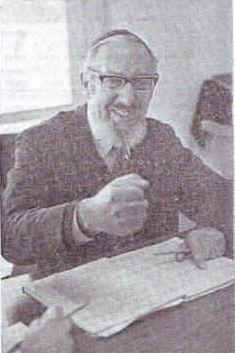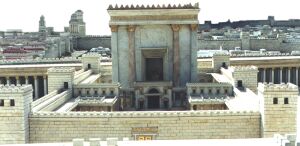 Freedom to Interpret by Rabbi Aryeh Carmell O.B.M.
Freedom to Interpret by Rabbi Aryeh Carmell O.B.M.
Freedom to Interpret
Rabbi Aryeh Carmell O.B.M.
“If you are unable to arrive at a clear decision in any legal matter –
between blood and blood between civil case and civil case or one affliction and another –
leading to controversy in your gates; then you shall rise and go up
to the place to be chosen by G-d. And you shall approach the Levitical priests
or the judge who will preside in those days, and you shall enquire
and they will declare to you the decision on that legal matter.
You shall then act in accordance with the instruction that they issue
from that place chosen by G-d… you shall not deviate [from this]
neither to the right nor to the left“. (Devarim 7: 8-11)
1. Through Their Mind
Here the Torah establishes a Supreme Court, later known as the Great Sanhedrin, whose decisions on all Torah matters are to be legally binding on all Israel. Say a great Sage comes to a conclusion opposed to that of the Sanhedrin, but the Sanhedrin rejects his reasoning. The Sage is entitled to keep his opinion; there is no “thought control” in the Torah. But in practice he must follow, and tell everyone else to follow, the decision of the Sanhedrin — right or wrong.1 On the other hand, if the Sage challenges the Sanhedrin and actively tries to influence people to act against their decision, he may find himself facing the death penalty.2
How can one be so sure that the Sanhedrin is right? Ramban poses this question. He answers that whatever the Sanhedrin by majority, decides, is ipso facto “right,” because the Torah was given to us according to the understanding of their [i.e. the Sanhedrin’s] mind.3
Hence, it is not the “absolute truth” which is required here, but the truth as seen by those qualified to pass judgment at any given time. Coincidentally, this ensures that a certain degree of flexibility is built into the Oral Law.
2. Not in Heaven
To illustrate this principle the Gemara records the well-known episode of Rabbi Eliezer’s challenge to a decision of the Sages led by Rabbi Yehoshua (first century C.E.). Rabbi Eliezer calls up a series of miraculous events to prove his point, all of which are rejected as irrelevant by Rabbi Yehoshua.
______________________
1. Sanhedrin 88a.
2. Devarim 17:12.
Finally a heavenly voice declares:
“What have you to say to my son Eliezer? The halacha is always as he says.” Upon hearing this apparently irrefutable declaration, Rabbi Yehoshua stands up and asserts, “The Torah is not in Heaven.”4 This means: the Torah has already been given and it states that all halachic decisions must be rendered by majority vote. We take no notice of a “heavenly voice.”5 The Gemara continues that the tanna Rabbi Nathan once met the prophet Elijah and asked him what had been G-d’s reaction to this. He replied: “He laughed and said, ‘My sons have defeated Me, My sons have defeated Me!”6
There are various interpretations of this final episode. To me it clearly implies that the “heavenly voice” was nothing but a test. Rabbi Yehoshua had to realize that there can be no change in the Torah’s principles and therefore the “heavenly voice” was meant to be rejected. They passed the test.
3. Halachah Only
The obligation to follow the assertion of the Sages applies only to halachic matters. As the passage cited at the head of this article emphasizes. Twice it notes that the decision we are searching for refers to a decision in mishpat “legal matters,” i.e. halacha. The Talmud delineates three basic areas of halacha, according to the answers given to these three questions: Prohibited or permitted? Liable or exempt? Pure or impure? The three examples given in the passage cited could well refer to these three areas: “between blood and blood” could refer to types of blood permitted or prohibited for consumption; “civil case -and civil case” refers to cases to which the verdict is “liable or exempt”; “one affliction and another” seems most likely to refer to different cases of leprosy, either “pure” or “impure” (tamé or tahor).7
4. Non-Halachic Subjects
So far we have been discussing halachic issues. But the Talmudic and Midrashic literature contains much more than this. It is true that the bulk of the Talmud consists of halachic discussions, but a substantial portion is devoted to non-halachic subjects.
_______________________________________________________
3. Rambam, Commentary, Devarim 17:11.
4. Devarirn 30:12.
5. Bava Metzia 59b.
6. Ibid.
7. See Vayikra ch. 13-14; Devarirn 24:8-9
We can divide these into three main kinds:
- Ethical lessons derived from verses in Tanakh. These can refer to relationship with G-d and man; character building; proper behavior, etc.
- Parables and allegories which, when properly elucidated, yield important lessons.
- Information mainly regarding various cures and treatments; also regarding some facts of biography, history, geology, astronomy etc.
All these three kinds of information are called aggadah, to distinguish them from halacha, which we discussed above.
5. Degrees of Authority
None of these carry an authority comparable to halachic decisions. The actual degree of authority varies in each case, as will now be shown.
- Ethical lessons derived from Tanakh. The aggadot and midrashim which our Sages have bequeathed to us are incomparably rich in wisdom and moral content. Their pure and noble minds drew from the wellsprings from Torah exceedingly profound insights. If “the casual conversation of a Sage requires careful study”,8 how much more what they said by way of instruction or homily. Yet they themselves laid down the rule “we derive no halacha… from aggada.”9 They are recommendations and suggestions rather than laws.
- Parables, etc. To take these literally would be to completely misunderstand their import, as Rambam emphasizes.10 Considerable research is required if one is to understand the message that is being conveyed. Once this has been grasped, their authoritative status is equal to that of (1).
Rabbi Shmuel ha-Nagid’s Introduction to the Talmud (printed in the first volume of our Talmud editions) includes this note: “Aggada comprises any comment occurring in the Talmud on any topic which is not a commandment (i.e. which is not halachic) and one should derive from it only that which is reasonable.” We are told to use our commonsense to decide whether an aggada is to be taken literally or not.
9. Jerusalem Talmud, Peah 2:4.
10 Mishna Commentary, Introduction to Sanhedrin chap. 10.
- Factual Information. This is certainly the most problematic of the three kinds of non-halachic material found in the Talmud. Not long after the close of the Talmudic era (ca. 500 CE.) the Geonim (Ca. 700-1000 C.E.) advised people not to practice the cures mentioned in the Talmud. One of the best known of the Geonim, Rav Sherira Gaon (Ca. 1000 CE.) writes as follows:
“We must inform you that our Sages were not physicians. They may mention medical matters which they noticed here and there in their time, but these are not meant to be a mitzvah. Therefore you should not rely on these cures and you should not practise them at all unless each item has been carefully investigated by medical experts who are certain that this procedure will do no harm and will cause no danger [to the patient]. This is what our ancestors have taught us, that none of these cures should be practised, unless it is a known remedy and the one who uses it knows that it can cause no harm”.11
6. Rambam and His Son
About two hundred years later, Rambam makes a similar comment on the Sages’ knowledge of astronomy. It reads as follows:
“Don’t ask me to reconcile all that they [the Sages] have said on astronomy with the facts as they are. The sciences at that time were deficient, and their statements on these matters are not based on prophetic tradition but on what was available to them at that time“.12
* * *
While discussing the availability to our Sages of the later developments of the sciences, one must never forget their supreme greatness in one area, which is the all- important one. I mean their G-d-given ability to interpret the Torah as it is to be practised in our everyday lives. As we saw above, it is through their minds that the Torah is channeled to all generations. Later on we shall suggest a reason why their minds were not enabled also to encompass scientific developments.
Rabbi Avraham, son of Rambam, although living in the shadow of his illustrious father, was considered, after his father’s death, one of the greatest of his generation (13th century). Elaborating on his father’s views, he also emphasized the great competence of our Sages in one all-important area:
11. Otzar Hageonim, Gittin 68, #376.
12. Moreh Nevukhim II, 14 (end).
The great excellence of the Sages of the Talmud in the interpretation of the Torah and the investigation of all its rules and details does not oblige us to accept all their statements in the spheres of medicine, natural science or astronomy. Nor need we believe them [in these matters] as we believe them in the interpretation of the Torah, since its deepest wisdom is theirs and it is their task to teach it to all.13
7. Where Does the Sun Go in the Night-Time?
Rabbi Avraham proceeds to bring a proof for this conclusion from the Gemara:
“Where does the sun go in the night-time? The Sages of Israel say: In the daytime the sun goes under the firmament and in the night-time above the firmament. The sages of the nations say: In the day the sun goes below the firmament and in the night, under the earth. Rabbi [Yehuda Ha-Nassi] said, ‘Their words are preferable to ours, because in the daytime springs are cold while in the night springs are hot“.14
This teaches us a very important lesson, writes Rabbi Avraham. Rabbi did not decide in accordance with the sages of the nations as one decides a halachic question, but from facts of observation. And with good reason Rabbi was known as “Rabbenu haKodesh” (“our holy master”), says Rabbi Avraham. When a person rejects the false and accepts the truth, and is prepared to retract his previous opinion when he understands that the converse is true, he is rightly called “holy.” We also see that the Sages did not judge an opinion by its author, however great he may be, but by the proofs that are adduced for it.
8. Freedom of Interpretation
The difference between halachic and non-halachic matters comes to the fore also in questions of interpretation. In halachah of course all the interpretation has long been done. Or perhaps nearly all. There may still be a question whether a verse is halachic or non-halachic. For example, take the verse: “And it shall be as a sign on your hand and a memorial between your eyes, so that the law of G-d shall be in your mouth…” 15 We all know what this means; in fact we put it into practice every day [when we don tefillin]. But is it the simple meaning?
Rashbam, Rashi‘s grandson, conceived of a new commentary on Chumash, which would leave more room for the simple meaning what he called “the depth of the pshat” and he obtained Rashi’s approval for this enterprise. And this is how he explained our verse:
13 Maamar al ha-Derashot, Ein Yaakov, p. XIV.
14 Pesachirn 94b.
15. Shemot 13:9.
“AS A SIGN ON YOUR HAND. According to the depth of its pshat (simple meaning), it shall be a constant memorial to you, as if it were written on your hand, like “make me as a seal on your heart” (Shir haShirim 8:6). BETWEEN YOUR EYES. Like an ornament or golden chain which it is customary to put on the forehead as an ornament”.
So Rashbam declares that this verse is metaphorical. His knowledge of linguistics and Biblical poetry compels him to this conclusion. But Rashbam, who was also a great halachist, would certainly not for a moment deny that it also comprises a mitzvah which has to be practised daily, as detailed by the Oral Law. There is no contradiction. The Oral Law simply tells us that the metaphor had to be converted into a series of actions — “suiting the action to the words.” It remains true that halacha can never be re-interpreted.
9. Some Non-Halachic Interpretations
On the question of Bil’am’s ass, the majority of commentators accept the narrative in its literal sense, and so do the Sages of the Mishna and Talmud. But Ray Saadya Gaon (10th century C.E.), compelled by his own ideas on miracles, asserts that the ass never spoke. It merely appeared to speak, while an angel did the speaking.16 Although this contradicts many authorities, it is not ruled out, since the context is non-halachic.
* * *
Again on the subject of miracles, Maharal of Prague, well known for his non- literal interpretations of many sources, discusses the halting of the sun by Joshua.17 In a long dissertation, Maharal concludes that the sun was stopped only for the Israelites, who needed the extra daylight, but for the Canaanites the sun and moon pursued their usual paths. It does not worry him that this implies that the sun and moon were standing and not standing at the same time.18 This is not the place to discuss what this actually implies regarding Maharal’s concept of miracles in general, but it is certainly not in accord with the generally accepted view, or with the literal sense of the verse. But we must remember that this is a non-halachic text.
There is a well-known and longstanding dispute in Torah sources regarding the status of necromancy and the “black arts” in general. Many hold that they are, or once were, effective, but were prohibited by the Torah. It seems clear that the Sages of the Talmud adopted this view. Others notably Rambam and his followers hold that all this is mere superstition. It was prohibited because of its connection with idolatry.
16. See Ibn Ezra on Bereishit 3:1 and Bemidbar 22:28.
17. Yehoshua 10:13.
There is one passage in Tanakh, concerning Saul and the witch of Ein Dor19, which seems to lend credence to the first view. The narrative describes how the woman succeeds in “bringing up” the spirit of the dead Samuel, who then holds a conversation with Saul.
One of the great Biblical commentators, Rabbi Levi ben Gershon (Ralbag 14th century), was a strong follower of Rambam. Compelled by his convictions on this matter, Ralbag explains the whole passage in a non-literal sense. He writes:
“In reality, no one was raised from the dead nor did any information reach Saul in reality. All this was the work of the imagination”.
He goes on to explain that the words Saul “heard” were in fact almost all words he had heard from Samuel in his lifetime, which were now being repeated to him by his own memory.20 We have here another example of unusual explanations being accepted when the writer’s convictions compel him — with good reason to accept them.
10. Tiberias in Jerusalem
One very outstanding example of the accuracy of our Sages in astronomy concerns the average length of the lunar month. Month to month variations make it very difficult to obtain an exact figure for this. The Talmud reports: Rabban Gamliel told them: I have a tradition from my grandfather’s house stating that the renewal of the moon is not less than a minimum of twenty-nine and one-half days plus two-thirds of an hour and seventy- three parts [a “part” being 1/1080 parts of an hour].21 If we take this figure to refer to the average lunar month (and not to the “minimum” stated), we get, in modern terminology, 29 days, 12 hours, 44 minutes. 3 1/3 seconds. This is in fact correct to within one half-second on the basis of modern astronomical observations which is precise to one part in five million!
Traditionally, this information was made available to our Sages at the time of Mattan Torah.22 Rambam tells us that the mathematical basis for these calculations was later developed by the Greeks.23
18. Maharal, Gevurat Hashern, 2nd preface.
19. I Shmuel, 28:8-19.
20. See also Redak ad loc who cites R. Shmuel ben Hofni as putting forward similar views.
21. Rosh Ha-Shana 25a.
22. Rambam, Mishneh Torah, Hi!. Kiddush Ha-Chodesh, 5:2.
23. Ibid. 17:24.
A fundamental mitzvah of the Torah requires the Sanhedrin to establish a solar- lunar calendar so that Pesach shall always fall in the Spring.24 Providentially, a solid basis was provided for this by the accurate determination of the lunar month described above.
It turns out, however, that when we consider the length of the solar year we do not find that the Sages possessed such accuracy. The rough-and-ready estimate of 365 ¼ days was known to be inaccurate but was retained for relatively minor matters such as the prayer for rain. This was known as tekufat Shemuel (3rd century C.E.), coinciding with the Julian calendar. When the Sages Rav Adda and Hillel 11(4th century) established the fixed calendar which we still use to the present day, a correction was made to the estimate of the solar year. It was now taken as 365 days, 5 hours, and 55,007 minutes. This was still 6 2/3 minutes in excess of the value established in modern times, but accurate enough to fulfill the purpose of the fixed calendar to ensure that Pesach never falls earlier than the vernal equinox.
It certainly seems that in the majority of cases; the Sages were left to their own devices, as Rambam and his son assure us. The question remains: Why? Would it not give tremendous prestige to the Torah Sages if they could also solve all scientific problems by prophetic tradition?
We could perhaps give an answer to this question by using an analogy. It is well- known that fruit that grew in Ginossar, near Kinneret, was extremely luscious. The Gemara raises a question:
“Why did Ginossar fruits not grow in Jerusalem? So that pilgrims should not say, “If we had come only to eat Ginossar fruit in Jerusalem it would have been enough!” Their pilgrimage would have been for selfish motives.
Why are the hot springs of Tiberias not in Jerusalem? So that the pilgrims should not say, “If we had only come to bathe in the hot springs it would have been enough!” — Their pilgrimage would have been for selfish motives”.25
We can use similar reasoning to answer our question. If greatness in Torah also implied greatness in science, our Torah learning would no longer be for its own sake but for the science it provided!
Let us pray for the time when we shall have the merit to find all the answers to all problems — both halachic and non-halachic!
_________________________________________________
24 Shemot, 12:2.
25. Pesachim 8b.





